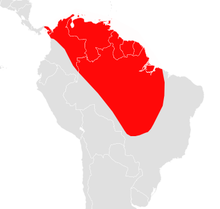
The New World leaf-nosed bats (Phyllostomidae) are found from southern North America to South America, specifically from the Southwest United States to northern Argentina. They are ecologically the most varied and diverse family within the order Chiroptera. Most species are insectivorous, but the phyllostomid bats include within their number true predatory species and frugivores. For example, the spectral bat, the largest bat in the Americas, eats vertebrate prey, including small, dove-sized birds. Members of this family have evolved to use food groups such as fruit, nectar, pollen, insects, frogs, other bats, and small vertebrates, and in the case of the vampire bats, even blood.

The spectral bat, also called the great false vampire bat or Linnaeus's false vampire bat, is a large, carnivorous leaf-nosed bat found in Mexico, Central America, and South America. It is the only member of the genus Vampyrum; its closest living relative is the big-eared woolly bat. It is the largest bat species in the New World, as well as the largest carnivorous bat: its wingspan is 0.7–1.0 m (2.3–3.3 ft). It has a robust skull and teeth, with which it delivers a powerful bite to kill its prey. Birds are frequent prey items, though it may also consume rodents, insects, and other bats.

The hairy-legged vampire bat is one of three extant species of vampire bats. It mainly feeds on the blood of wild birds, but can also feed both on domestic birds and humans. This vampire bat lives mainly in tropical and subtropical forestlands of South America, Central America, and southern Mexico. It is the sole member of the genus Diphylla.

The white-winged vampire bat, a species of vampire bat, is the only member of the genus Diaemus. They are found from Mexico to northern Argentina and are present on the islands of Trinidad and Margarita.

The black-winged little yellow bat is a species of vesper bat native to Central America.

The little big-eared bat is a bat species in the order Chiroptera and family Phyllostomidae. It is from South and Central America particularly Colombia, Venezuela, Guyana, French Guiana, Brazil, Peru, Ecuador, Bolivia, Argentina, Paraguay, Suriname and Trinidad. Though its exact population is unknown, it is considered widespread and occurs in protected areas, although its minor threats may be deforestation, but nonetheless is classified Least Concern. It is found in multistratal evergreen forests and dry thorn forests and forages near streams and is found hollow trees, logs, caverns, or houses with groups up to twelve. The head and body length measures at 43.8 mm for males and 44.6 for females and males usually weigh about 5 g while females weigh 5.7 g.

The visored bat,, is a bat species from tropical South America. It is the only species in the genus Sphaeronycteris. Although visored bats have some unique characteristics, they are thought to be most closely related to little white-shouldered bats and wrinkle-faced bats.

The Incan little mastiff bat is a species of bat in the family Molossidae, the free-tailed bats. It belongs to the subgenus Micronomus.
The Guadeloupe big brown bat is a species of vesper bat. It is found only on the island of Guadeloupe. It is one of the 11 species of bat found on Guadeloupe, and one of the 3 that are endemic.

The Gambian epauletted fruit bat is a species of megabat in the family Pteropodidae.

The Cuban fig-eating bat, or white-shouldered bat, is a species of bat in the family Phyllostomidae, found only in the Caribbean. It is the sole extant species in the genus Phyllops, although two other species, P. vetus and P. silvai, are known from fossils.

The red fruit bat or red fig-eating bat is a species of bat in the family Phyllostomidae, in the monotypic genus Stenoderma. It is found in Puerto Rico and the U.S. Virgin Islands.

The montane monkey-faced bat or montane flying monkey is a megabat endemic to the Solomon Islands. It is listed as a critically endangered species. Due to its imperiled status, it is identified by the Alliance for Zero Extinction as a species in danger of imminent extinction. In 2013, Bat Conservation International listed this species as one of the 35 species of its worldwide priority list of conservation. Only one individual has ever been found.

The Guadalcanal monkey-faced bat or Guadalcanal flying monkey is a megabat endemic to Solomon Islands. It is listed as an endangered species. In 2013, Bat Conservation International listed this species as one of the 35 species of its worldwide priority list of conservation.

Stenodermatinae is a large subfamily of bats in the family Phyllostomidae.

Scotophilus is a genus of vespertilionid bats commonly called yellow bats. They are found in southern Asia and Africa. They are the only members of the tribe Scotophilini.

The greater monkey-faced bat or greater flying monkey is a megabat endemic to Solomon Islands, Bougainville, in Papua New Guinea, and nearby small islands. It is listed as a critically endangered species and the population is decreasing. It is the largest monkey-faced bat.
Rosevear's serotine is a species of vesper bat that lives in Guinea and Liberia. It was described as a new species in 2013. It is listed as endangered by the IUCN.

















